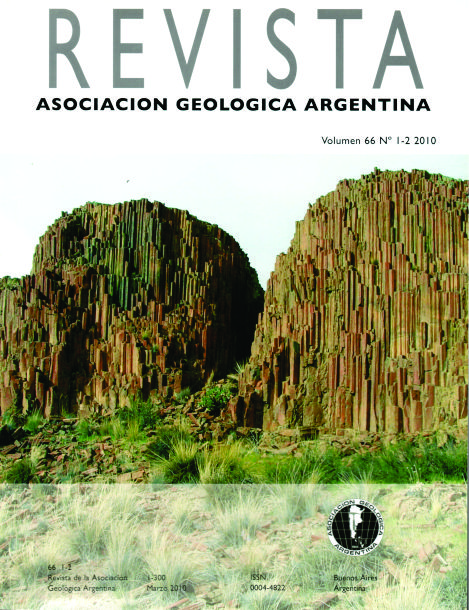Textural variations and chemical mobility during mylonitization: the El Tigre granitoid shear zone, Sierra de Pie de Palo, western Sierras Pampeanas, San Juan
Main Article Content
Abstract
A high-strain ductile shear zone trending NEE with southeasterly dipping mylonitic foliation, has been recognized
affecting a Mesoproterozoic (ca. 1105 Ma) peraluminous garnet-bearing two mica granitoid (El Tigre granitoid: 31º31'30''S-
68º15'12''W) which is part of the crystalline basement of the Sierra de Pie de Palo, Western Sierras Pampeanas. Kinematic
analysis indicates a main strike-slip component and provides evidence that the relative movement within the shear zone have
dextral sense. Relict igneous and peak amphibolite facies metamorphic mineral assemblages and textures are preserved in the
granitoid protolith although, within the shear zone, deformation obliterates those generating typical mylonitic fabrics.
Mylonitization operated under open-system conditions, provoking mobilitization (either enrichment or depletion) of almost
all major and trace elements, including rare earth elements and Rb/Sr and Sm/Nd isotopes. Observed chemical variations are
mostly controlled by syntectonic fluid-transport processes and decrease in the garnet, biotite and accessory minerals amounts
during mylonitization, and the neoformation of white-mica in the fine-grained mylonite matrix. Moreover, the different isotopic
signatures between the protolith and the mylonites could be a consequence of mechanisms of deformation-driven processes
assisted by fluid flow with different fluid-host rock interaction ratios. Textural, modal and chemical changes between
the El Tigre granitoid protolith and its mylonites, allow reconstructing its tectono-metamorphic evolution and the metamorphic
conditions achieved. Paragenetic associations and deformation textures on mylonites suggest that El Tigre granitoid shear
zone was developed under low-T greenschist facies conditions, probably at temperatures below 400 °C. This deformational
event took place at ca. 473 ± 10 Ma during the Famatinian orogeny.
Article Details

This work is licensed under a Creative Commons Attribution-NonCommercial 4.0 International License.
Nota de copyright
Los autores conservan los derechos de autor y garantizan a la revista el derecho de ser la primera publicación del trabajo licenciado según una licencia de atribución Creative Commons que permite a otros compartir el trabajo con el reconocimiento de la autoría y de la publicación en la que se publicó por primera vez.
Declaración de privacidad
Los nombres y direcciones de correo electrónico introducidos en esta revista se usarán exclusivamente para los fines declarados por esta revista y no estarán disponibles para ningún otro propósito u otra persona.

